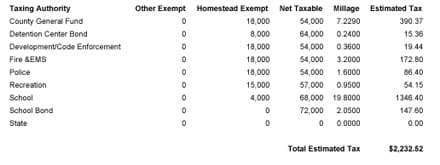The intent of the notice is to provide property owners with the current value associated with their property for the ad valorem tax process compared to last year’s value as well as an estimate of taxes based on the new/current value. The mandated calculation process for the estimated taxes often results in a figure that is different from actual taxes for the property; additional discussion of this is included below.
Approximately 60 percent of all the properties will see a change in value from the previous year. Property sales confirm the continuation of increases in property values. The general rise in values is a direct result of an improving economy as sale prices are continuing to move toward pre-recession levels.
The following table provides information included on an assessment notice. This example shows the estimated taxes for a parcel that saw a fair market value increase over the previous year due to market conditions. This sample parcel had a previous year fair market value of $160,000 (40 percent assessed value of $64,000) and a current fair market value of $180,000 (40 percent assessed value of $72,000.
In the example above, the estimated ad valorem tax bill for the current year is based on the previous or most applicable year’s net millage rate and the fair market value contained in the assessment notice. The estimate may not include all eligible exemptions and it does not include fees such as solid waste, storm water, street lights and speed bumps. Therefore, the actual tax bill the property owner receives may be more or less than the estimate.
Chief Appraiser Steve Pruitt says his office is in compliance with new state laws implemented over the last several years, including the required use of the state of Georgia’s Notice of Assessment form and changes to the appeal process. In addition, recent changes in the state’s methodology for testing the accuracy of tax values have contributed to the large number of value changes this year. Pruitt estimates the overall net property tax digest will increase between 5 and 6 percent in 2016 once the impact of appeals and changes in certain exemptions are finalized.
The property tax digest is the total value of all property subject to taxation and can change in two ways. The first is through value updates that reflect sales prices of similar properties and the second is growth caused by construction activity. The increase in value from value updates requires consideration of a rollback in the tax rate to remain revenue neutral. As stated previously, the property tax estimate on the notice must use last year’s tax rates, may not include all eligible exemptions and may be more or less than the actual tax bill. The actual tax bill will be based on the 2016 tax rates set by the Board of Commissioners and the Board of Education later this year.
Property owners have 45 days from the date of the notice to file an appeal by using the statewide uniform appeal form (PT311A). Property owners who choose to appeal may submit appeals online at www.gwinnett-assessor.com. Assessment notices, forms and appeal information, including FAQs, can also be found on the webpage. Property owners may also contact the Tax Assessors’ Office by email at assessor@gwinnettcounty.com or by telephone at (770) 822-7200 for assistance.



